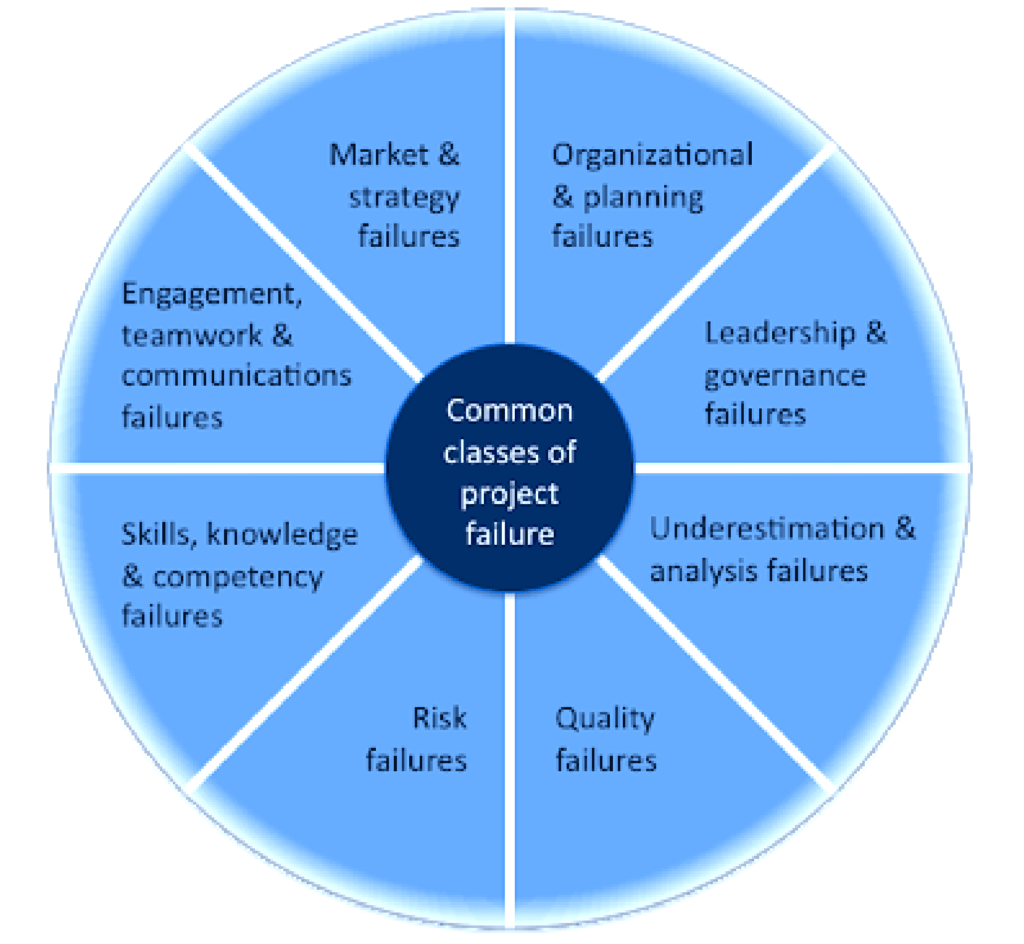Why Projects Fail?
Introduction
Each year, enterprise organizations around the world face astronomical project failure rates, often wasting millions of dollars per failed project. The same enterprises agonize over the causes of project failure, call in expensive consultants to assess and recover failing projects, and often abandon what originally seemed like well-planned, well-organized projects, destined for success.
There is no single method or organizational structure that can be used to manage projects to success. Different organizations handle the functional projects differently.
Besides a well defined charter, the list that follows summarizes some of the major project management functions that are necessary to achieve success in projects:
- Recruit and maintain adequate technical and non-technical resource skills
- Manage the allocation of scarce resources
- Define and collect operational metrics to support project and stakeholders decision making
- Promote efficient and effective communications
- Select and utilize technology related tools
Many project management professionals who work well in this area would say that the list consolidates a significant and sometimes overwhelming task.
Why Projects Fail?

Project failure can happen in any organization and to any project. There are an infinite number of reasons for failure. Sometimes it’s out of the control of a project manager and/or the team members. Sometimes failure is controllable. Failed projects and people involved with the failure have some things in common. In both cases they are given prescriptions for “quick fixes” which typically prove to be ineffective and can sometimes produce disastrous side effects.
Using a medical metaphor, flu’s are viral and are unresponsive to antibiotic drugs. For projects, technology is the antibiotic often prescribed. Suggestions like, upgrade your software for tracking the project, use the critical chain instead of the critical path, or use a Monte Carlo simulation to compute the project risks. In many cases, these powerful interventions fail because they are inappropriately applied.
The goal of project management is to produce a successful product or service. Often this goal is hindered by the errors of omission as well as commission by management, project managers, team members and others associated with the projects. The purpose of this paper is to enable the identification of the common causes of project failures through the use of surveys and questionnaires to provide information which can be used to mitigate their occurrence and in many cases repair the damage caused and hopefully, recover the projects.
Projects most commonly fail because there is a lack of attention and efforts being applied to seven project performance factors:

Focus on business value, not technical detail. This involves establishing a clear link between the project and the organizations key strategic practices. The project plan needs to cover t he planned delivery, the business change required and the means of benefits realization.
Establish clear accountability for measured results. There must be clear view of the interdependencies between the projects, the benefits, and the criteria against which success will be judged. It is necessary to establish a reasonably stable requirement baseline before any other work goes forward. Requirements may still continue to creep. In virtually all projects there will be some degree of “learning what the requirements really are” while building the project product.
Have consistent processes for managing unambiguous checkpoints. Successful large projects typically have software measurement programs for capturing productivity and quality historical data that can be sued to compare it against similar projects in order to judge the validity of schedules, costs, quality, and other project related factors. The lack of effective quality centered mechanisms can be a major contributor to both cost and schedule overruns.
Have a consistent methodology for planning and executing projects. There should be a detailed plan developed before any release date of a project is announced. Inadequate planning is one of the major reasons why projects spin out of control.
Include the customer at the beginning of the project and continually involve the customer as things change so that the required adjustments can be made together. It has been observed that successful projects occur when end users (customers) and the project members work as teams in the same cubicle, although this is not always possible. Projects are less likely to fail if there are informed customers giving meaningful input during every phase of requirements elicitation, product description and implementation. The customer needs to be asking, “how are the project result used over time and what do I get out of the results?
Manage and motivate people so that project efforts will experience a zone of optimal performance throughout its life. This involves managing and retaining the most highly skilled and productive people. Knowledge is money. A project team made up of higher paid people with the right specialized skills is worth more per dollar than a group of lower cost people who need weeks or months of training before they can start to be productive.
Provide the project team members the tools and techniques the need to produce consistently successful projects. The project team must be skilled and experienced with clear defined roles and responsibilities. If not, there must be access to expertise which can benefit those fulfilling the requisite roles.

